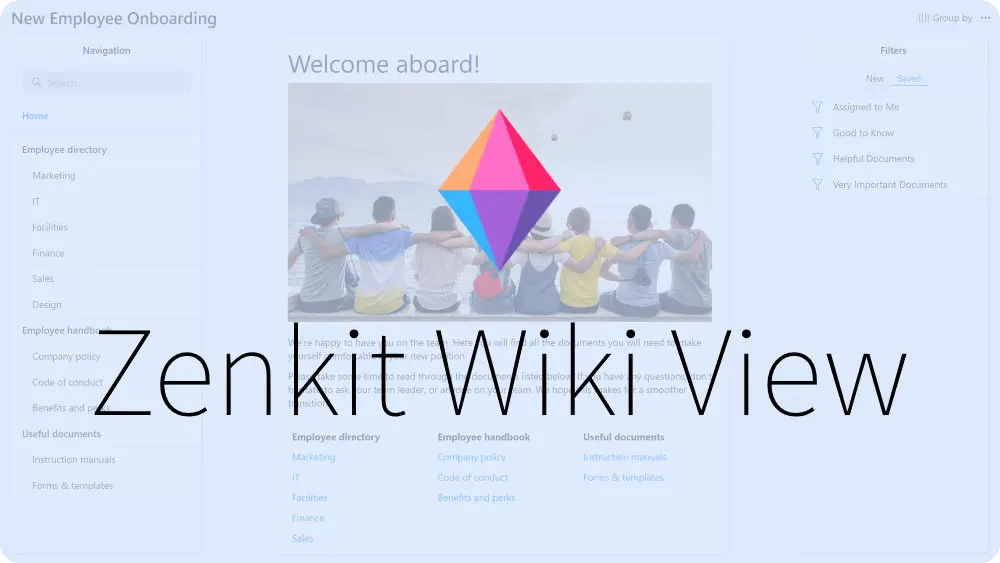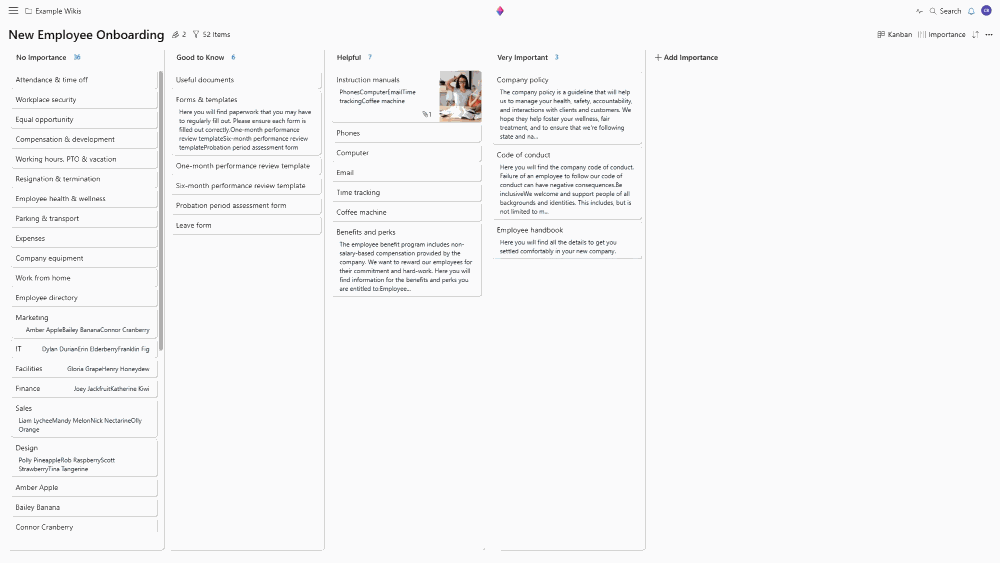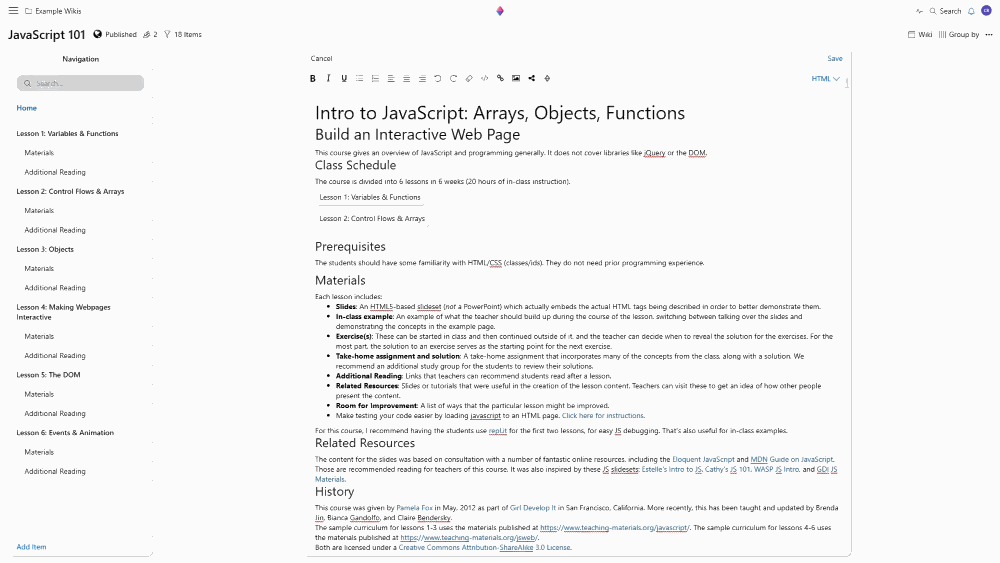Introducing Wiki View for Zenkit
Create and publish your own team wiki in moments!

Wikis have been around almost as long as the web itself. The first wiki was published in 1994, a mere 4 years after Tim Berners Lee launched the World Wide Web. Since then, wikis have been used by millions around the world as a convenient way to collaborate on and publish information.

As a content management system, they’re easy to use and give non-technical users the ability to quickly publish content. It wasn’t long before companies and organizations caught on, publishing internal wikis (or team wikis) to keep everyone on the same page, with access to the same resources and info.
Why a Wiki View?
With the wiki view, we wanted to make it easy for teams to be able to quickly and easily disseminate information internally, or publish it for others to see. Wikis are so ingrained in our use of the web (who hasn’t ever checked Wikipedia?) that they’re very easy for anyone to understand in terms of structure and readability. While you could use a normal Zenkit collection to create a team wiki in, say, Kanban or list view, published or not, there’s something special about being able to read the text in the same way that you would elsewhere online.
So why not something else? What happened to Gantt? (I knew you’d ask.) Don’t worry Gantt is coming very, very soon! But while we’re waiting, there’s nothing better than a wiki to tide you over.
Why Wikis Are So Great

Successful companies owe their success, in part, to high levels of team collaboration and connection across departments. When there is effective knowledge management and sharing in an organization, individuals across the company are able to act based on a common vision, understanding of the company, and shared resources.
Whether you’re a distributed team or working at the same desk as your boss, the reality for many of us is that we have multiple roles to fill, juggling different responsibilities and priorities across different apps and devices. A centralized wiki or knowledge base keeps everyone, from new employees to old hands, on the same page and updated with the latest intel.
Onboarding New Team Members
Onboarding new team members is always a bit more work than you’d expect. New employees need to get to know the company culture, norms, rules, and regulations. Then there are the processes that keep the company running day to day, and new projects they need to get up to speed on. Often it’s difficult to impart all of this information to someone without completely overloading them.
A well-organized onboarding wiki can help employees learn how things work, and gives them a clear idea of where to find answers to any questions they may have. An internal wiki that points the way can relieve the burden on managers and other team members, and even improve first-year retention rates!
Cross-Training
Companies that are able to cross-train their employees can strengthen engagement and performance throughout the organization. Team members who have a more holistic view of other roles within the company are ultimately more valuable as they learn new skills, are able to work effectively in multiple roles, and even perform the same role with higher engagement and customer empathy.
An internal wiki can act as a repository for customer support material, training documents, business policies and best practices, how-to guides, and much more. Having all this information available in a central location means that it’s easy for team members to access the info they need to get up to speed in any area of the organization.
Collect and Preserve Company Knowledge
Another key benefit of wikis is that they offer a dedicated place for employees or managers to record knowledge they’ve gained over years on the job. If a key team member leaves the company without recording their knowledge anywhere, they’re effectively taking all that knowledge with them. It’s very difficult to find someone who has the same experience with the company, projects, team, and strategies that the leaver had.
Internal wikis become a vital way for companies to retain the knowledge and expertise of their employees. If you’re able to create a culture where team members regularly update an internal wiki with their ideas, research, strategies, and anything else they use on a day to day basis, it becomes much easier to train replacements.
Improve Internal Communications
If it’s not become clear in the last couple of points, I’ll state it again: wikis can play a huge role in improving internal communication, especially when it comes to collecting and imparting company knowledge. The more transparent and easily accessible internal information is, the easier it is for individuals in a company to act as one, with shared goals and vision.
A wiki can be used by project managers to keep everyone informed of project statuses, by HR to notify the team of updated policies or procedures, by designers to share design materials and brand guidelines, by managers to introduce new people to the team, or inform everyone of the details for the next company party.
Basically, whenever you want to send a team or company-wide email or make an announcement in a Slack channel, or need to ask someone for a resource, consider a wiki instead!
The Zenkit Difference: How to Use Uour Zenkit Wiki
“But wiki software already exists!” you may be saying. But that’s where the Zenkit difference comes in. Our wiki view enables you to quickly and intuitively create and publish wiki pages from your existing Zenkit collections. As such, you can benefit from everything else that makes Zenkit special, without having to outsource this integral tool to other software!
With the Zenkit wiki view, you can create, edit, and publish from any device, anywhere. From the desktop, web, or your phone, if it’s in Zenkit, it can be published. If you’re already using Zenkit, then you already know how to create a wiki with it—just use the same tools and techniques you’ve been using to run everything else, then switch to the wiki view. Done!

Ok, maybe not completely done yet – you can optionally add intro text, embed images or media from other sites, change the width of the page and text, and modify the table of contents based on label, hierarchy, or member fields.

One of the best things about the Zenkit wiki is that wiki readers can use the same powerful filters to quickly pinpoint the exact information they need. You can even create saved filters that can be accessed by readers so they can find relevant subsets of wiki articles without a thought.
You can learn a lot more about using Zenkit’s wiki view in our Knowledge Base (which has been an alpha version of the wiki for years!).
Three Tips for Setting Up Your Team Wiki
If you haven’t already started creating some form of internal knowledge base or wiki, it can be hard to know where to start.
1. Find out what you don’t know
If you just start writing things down without first figuring out what exactly needs documenting, you may end up only covering a small part of what’s needed, or even worse, wasting time documenting stuff that isn’t necessary. To make sure you’re off on the right foot, you can send a survey around the company asking for documents that everyone needs but are hard to find, or polling teams for the resources they regularly use. Better yet, get people from different teams and departments to collaborate with you! They’ll be able to pinpoint things that you might overlook.
2. Collaborate, but control access
Many hands make light work, but too many cooks spoil the broth. The more people you get collaborating with you on the wiki, the richer and more diverse it’ll be. That being said, some people don’t need full access to create, edit, and delete articles. Brand new employees, interns, consultants, or temp workers may need to be able to read articles, but they likely won’t be able to contribute. Additionally, members of the marketing team won’t need access to the dev team’s resources, and the dev team don’t need info about HR’s internal processes. You need to be able to control who has access to what.
3. Encourage engagement!
Don’t just publish it into the void and expect people to start using the wiki straight away. A wiki is only effective if it’s used regularly and kept up to date, so you need a strategy to get everyone on board with using it. Getting people from other teams to help you build it from the very beginning is a great way to start spreading the word, however, an internal marketing campaign, sharing links to new pages, or posting it in group channels can all help.
Adoption will increase if it becomes part of the day-to-day routine, so it’s also important to consider how the wiki can be included in existing processes.
We’re really excited about the wiki view, and have been using it ourselves for a while! Do you use an internal wiki? Please feel free to share your top wiki tips in the comments below. We hope you’ll enjoy using wiki view as much as we’ve enjoyed building and testing it!
Cheers,
Siobhan and the Zenkit Team
FREE 20 MIN. CONSULTATION WITH A PROJECT MANAGEMENT EXPERT
Wanna see how to simplify your workflow with Zenkit in less than a day?
Book a Live Demo
Waow ! Wonderful extension of Zenkit ! Congratulations !
Now wiki is available, any chance of adding LaTeX math formulas?
Thanks Howard! I’ll ask the dev team about adding formulas. We’re planning to work on formulas/table view next year, but I don’t know how advanced everything will be.